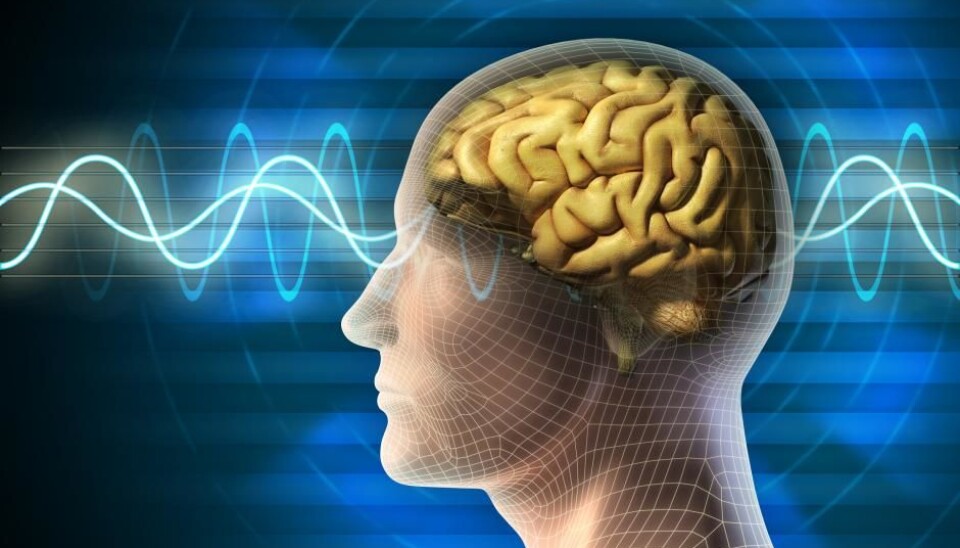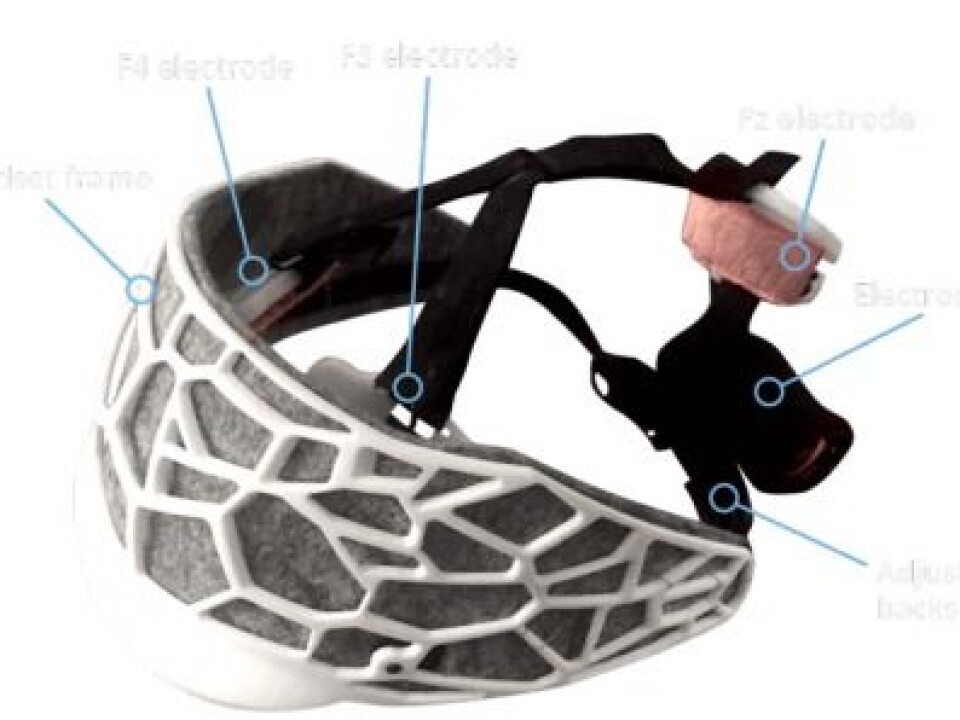
Can electric pulses to the brain boost your creativity?
Two entrepreneurs want to boost your creativity by sending a current through your brain, but most brain scientists are sceptical. ScienceNordic gave the method a try.
My skin itches a bit where the two electrodes are attached to my forehead.
The current is gradually increased. I’m told it will pinch the skin if turned up too quickly.
I can definitely feel it.
“Something is happening,” I say.

A strange sensation shoots through my body. It’s kind of creepy.
Then I start to laugh.
“Oh, that’s normal,” says an unaffected Morten Friis-Olivarius, postdoc at the Copenhagen Business School (CBS) Center for Decision Neuroscience, Denmark.
“When the creative mood is stimulated it makes your body feel a bit bubbly. You might feel a little silly the first time you try it--kind of as if you were tipsy.”
Helmet sends current into the brain

Friis-Olivarius is a brain scientist. For the past ten years he has studied what happens in the brain when we are creative.
Now, he and his colleague, Balder Onarheim, who is a lecturer in industrial design at the Technical University of Denmark (DTU), have developed a device that supposedly stimulates creativity by shocking the brain with two milliamps of current.
The device is worn on the head like a helmet. I’m told that it will stimulate my creativity when the current is turned up, and improve my concentration when it is turned down.
“It’s going really well,” says Onarheim, who placed the helmet over my head a few moments ago. “We’ve finished increasing it, so now we’ll turn it down as stably as we can.”

He cheerfully informs me that my brain is currently receiving between 1.3 and 1.4 milliamps.
With the control of an app, he gradually lowers the current. The app also allows him to monitor the contact between the electrodes and my head. In principle, I could be doing this myself at home.
Read More: New book shows you how to work creatively
Helping neurons to fire
The electrodes are positioned right on top of the area that is stimulated when we are being creative, says Friis-Olivarius.
The current does not change the brain at all, it just augments a natural process, he says.
The brain’s 125 billion nerve cells, neurons, are constantly firing and sending electric pulses to one another. The scientists are simply amplifying the process by sending their own current into the brain.
“We apply a little bit of current so it becomes a little easier for your neurons to fire,” says Onarheim.
“We’ll leave you in here now, and then you can just sit here and work, or think, or do whatever you want.”
“Have a good time!” he says, closing the door behind him.
Read More: Creativity facilitates learning
People can make their own tDCS helmets
Onarheim and Friis-Olivarius are the co-founders of the company “Plato,” which produces the helmets. Right now, they have sold 25 helmets for people to test.
But it is by no means the first of its kind.
The technique behind it is called Transcranial Direct Current Stimulation (tDCS), and it is used increasingly by both amateurs and professionals.
You can buy similar helmets on the internet, advertised as being able to reduce stress, help you sleep better, improve your concentration, and a lot more. There are endless YouTube videos where users recount their experiences with using these types of helmets.
Read More:
Electricity eases depression
But there is only one area in which tDCS is proven to be effective, and that is in treating depression.
A number of controlled experiements have shown that severe depression patients, who cannot be helped by medicine or other conventional treatments, sometimes experience improvements after receiving short electrical pulses to their head.
Scientists have developed a similar helmet to treat clinical depression.
“Put simply, the brain cells in a person with depression are bad at communicating with each other,” says one of the scientists behind the helmet treatment, Professor Steen Dissing from the University of Copenhagen, Denmark.
“The helmet’s electrical pulses recreate some of the brain’s natural electric fields, which activates nerve cells and cells in the capillaries. This increases the brain’s activity level,” he says.
Read More: New study finds proof that creativity and mental illness are genetically linked
Scientists are sceptical of the ‘creativity helmet’
However, there is currently no evidence that tDCS has any effect on learning ability, creativity, or concentration.
For that reason, Dissing and the other brain scientists that ScienceNordic has spoken to, are sceptical of the new helment.
“I think that we should take great care when we tamper with the electric signals in the brain,” says Professor Andreas Roepstorff, head of the Interacting Minds research centre at Aarhus University, Denmark.
“We don’t know if it works, or whether there are any side-effects in the short- or long-term. I’m not familiar with this exact device, but in my opinion, there should be evidence that it works before we start playing with electric currents in the brain,” he says.
Read More: Mice experiments explain how addiction changes our brains
Impossible to control tDCS
There is still a lot that scientists do not know about the brain. Neurons are connected with each other in an extremely complicated network that we do not fully understand.
It is almost impossible to control specific processes by sending a current through the brain, says Roepstorff.
“You might feel stimulated and more creative after electrical stimulation, but you could feel the same way after a glass of wine,” he says.
“Simply helping the neurons to fire does not guarantee that you become more creative, have brighter ideas, or that you become better at realising them.”
Read More: Boosting the brain can lead to an overload
There is not one place for creativity in the brain
Professor Jesper Mogensen, a neuroscientist from the University of Copenhagen, is also highly sceptical of the effectiveness of these types of techniques.
“I don’t know this specific device, but in general I’m of the opinion that there should be scientific studies to support the method when stimulating areas of the brain,” he says.
He also doubts that creativity can be stimulated by electrical pulses.
“There’s no doubt that you can change the activity in diverse areas of the brain with electrical stimulation. The question is whether the stimulation has the effect that you want to achieve. If you want to stimulate creativity, then you need to hit the right area,” says Mogensen.
“My evaluation is that it’s very difficult to do. Creativity is many things and it varies from person to person. I don’t know of any study that has found a specific area of the brain associated with creativity. Of course I can’t be certain that the device doesn’t work--but I’d like to see the scientific evidence before I consider believing that it does work,” he says.
Read More: How music touches the brain
Thoughts flow
Back in Friis-Olivarius’s office I am feeling elated and carefree.
It feels a bit like relaxing with a beer after work.
Have the electric pulses stimulate my creativity? I pull out my notebook and start to work on an idea for an article that I’ve been struggling with.
I can hear voices on the street outside the window.
I set pen to paper. The voices from the street fade, and thoughts begin to flow in my head. One after another they are placed on the paper in a string of sentences. My pen struggles to keep up.
One thing is sure, I do not have writers’ block.
Read More: Tablets help students write faster – but is that better?
Time flies with tDCS
Time flies and the door opens. Twenty minutes have passed.
Onarheim switches off the current and I take the helmet off. It feels like just five minutes have passed since I was left alone in the office.
“So how did it go? We’re interested to hear,” says Friis-Olivarius.
“I felt a bit restless. It might just be my imagination but I felt as if I was in some kind of flow,” I tell him.
“Like everything is bubbly? A myriad of thoughts?” asks Friis-Olivarius.
“Yes, and all of a sudden I found myself busy writing lots of things down.”
“As a journalist, you’re already creative on a daily basis. The helmet doesn’t make you more creative than you are normally. It just helps you to get into the flow of things. That’s certainly the intention,” says Friis-Olivarius.
“Of course it can’t be excluded that you experienced some kind of a placebo effect in this little experiment,” he adds. “But the important thing is that you got something out of it.”
Read More: Creative machines: The next frontier in artificial intelligence
Testers will evaluate the helmet
Friis-Olivarius and Onarheim know that there is no scientific evidence to back their helmet’s intended function. And they are well aware that many scientists are highly critical of tDCS as a creativity stimulus for that very reason.
That is why they have limited their sales to 25 testers around Europe. Each tester will take part in a type of experiment that Friis-Olivarius and Onarheim can follow using an app.
The testers will document what they get out of using the helmets and which type of exercises they solve when they have the helmet on.
“So far, they buy into a kind of membership of a program that we’re upgrading all the time. We don’t know when the final product will be available to everyone--it depends on the feedback we get,” says Friis-Olivarius.
He refers to the experiment as “crowd science.”
Read More: Citizen scientists will make new technologies available to everyone
Should tDCS be regulated?
For the time being, it is not necessary to get a permit to sell tDCS devices--as long as they are not sold for medical treatments and remain within certain technical safety limits.
Both Friis-Olivarious and Onarheim hope that there will be some regulation soon.
“Right now it’s a bit of a wild west out there,” says Onarheim. “There are a lot of suspicious tDCS devices from a lot of strange suppliers who promise all kinds of things.”
He is confident that the Plato device would be able to pass any regulations.
“It would be an advantage to us. Stricter regulation would mean that we could get an official stamp of approval,” says Onarheim.
I still feel uplifted and carefree as I leave Friis-Olivarious’ office.
On my way out, I pass a group of students sitting with their laptops in front of them. I can’t help but imagine them in a sci-fi world, where they all sit with electrodes attached to their heads as they brainstorm projects and exam questions.
Perhaps that world is not so far away.
-------------
Read the Danish version of this article on Videnskab.dk
Translated by: Catherine Jex








